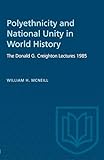Polyethnicity and National Unity in World History : The Donald G. Creighton Lectures 1985 / William H. McNeill.
Material type: TextSeries: HeritagePublisher: Toronto : University of Toronto Press, [1986]Copyright date: ©1986Description: 1 online resource (96 p.)Content type:
TextSeries: HeritagePublisher: Toronto : University of Toronto Press, [1986]Copyright date: ©1986Description: 1 online resource (96 p.)Content type: - 9780802066435
- 9781487582623
- 323.1/71
- online - DeGruyter
| Item type | Current library | Call number | URL | Status | Notes | Barcode | |
|---|---|---|---|---|---|---|---|
 eBook
eBook
|
Biblioteca "Angelicum" Pont. Univ. S.Tommaso d'Aquino Nuvola online | online - DeGruyter (Browse shelf(Opens below)) | Online access | Not for loan (Accesso limitato) | Accesso per gli utenti autorizzati / Access for authorized users | (dgr)9781487582623 |
Browsing Biblioteca "Angelicum" Pont. Univ. S.Tommaso d'Aquino shelves, Shelving location: Nuvola online Close shelf browser (Hides shelf browser)

|

|

|

|

|

|

|
||
| online - DeGruyter Commitment and Change : Georges Sorel and the idea of revolution / | online - DeGruyter The Interregional Effects of Canadian Tariffs and Transportation Policy / | online - DeGruyter Life Insurance, Annuities & Pensions : A Canadian Text (3rd Edition) / | online - DeGruyter Polyethnicity and National Unity in World History : The Donald G. Creighton Lectures 1985 / | online - DeGruyter Lope de Vega Studies 1937-1962 : A Critical Survey and Annotated Bibliography / | online - DeGruyter The Arthur Papers : Volume 3 (April 1840-June 1850) / | online - DeGruyter Of Several Branches : Essays from the Humanities Association Bulletin / |
restricted access online access with authorization star
http://purl.org/coar/access_right/c_16ec
Schools have taught us to expect that people should live in separate national states. But the historical records shows that ethnic homogeneity was a barbarian trait; civilized societies mingled peoples of diverse backgrounds into ethnically plural and hierarchically ordered polities. The exception was northwestern Europe. There, peculiar circumstances permitted the preservation of a fair simulacrum of national unity while a complex civilization developed. The ideal of national unity was enthusiastically propagated by historians and teachers even in parts of Europe where mingled nationalities prevailed. Overseas, European empires and zones for settlement were always ethnically plural; but in northwestern Europe the tide has turned only since about 1920, and now diverse groups abound in Paris and London as well as in New York and Sydney. Age-old factors promoting the mingling of diverse populations have asserted this power, and continue to do so even when governments in the ex-colonial lands of Africa and Asia are trying hard to create new nations within what are sometimes quite arbitrary boundaries. In demonstrating how unusual and transitory the concept of national ethnic homogeneity has been in world history, William McNeill offers an understanding that may help human minds to adjust to the social reality around them.
Mode of access: Internet via World Wide Web.
In English.
Description based on online resource; title from PDF title page (publisher's Web site, viewed 01. Nov 2023)


